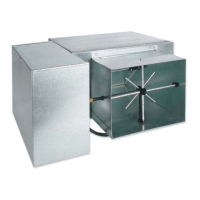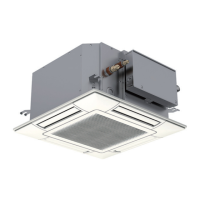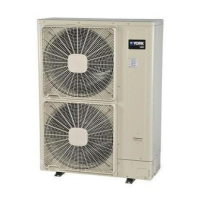349218-JIM-F-0512
30 Johnson Controls Unitary Products
module) to the “A”, “B”, “C” or “D” setting corresponding
to the lettered curve of the Enthalpy Set Point
Adjustment Figure 17.
• For a dual enthalpy operation, carefully turn the set point
adjusting screw fully clockwise past the "D" setting.
Power Exhaust Damper Set Point
With power exhaust option, each building pressurization
requirement will be different. The point at which the power
exhaust comes on is determined by the economizer damper
position (Percent Open). The Exhaust Air Adjustment Screw
should be set at the Percent Open of the economizer damper at
which the power exhaust is needed. It can be set from 0 to
100% damper open.
Indoor Air Quality AQ
Indoor Air Quality (indoor sensor input): Terminal AQ accepts a
+2 to +10 Vdc signal with respect to the (AQ1) terminal. When
the signal is below it's set point, the actuator is allowed to
modulate normally in accordance with the enthalpy and mixed
air sensor inputs. When the AQ signal exceeds it's set point
setting and there is no call for free cooling, the actuator is
proportionately modulated from the 2 to 10 Vdc signal, with 2
Vdc corresponding to full closed and 10 Vdc corresponding to
full open. When there is no call for free cooling, the damper
position is limited by the IAQ Max damper position setting.
When the signal exceeds it's set point (Demand Control
Ventilation Set Point) setting and there is a call for free cooling,
the actuator modulates from the minimum position to the full
open position based on the highest call from either the mixed
air sensor input or the AQ voltage input.
• Optional CO
2
Space Sensor Kit Part # 2AQ04700324
• Optional CO
2
Sensor Kit Part # 2AQ04700424
Replace the top rear access panel on the unit.
Optional BAS-Ready Economizer Power Exhaust
Damper Set Point Adjustment
Remove the economizer access panel from the unit. Loosen,
but do not remove the two panel latches. Locate the
economizer actuator, where the following adjustment can be
made.
With power exhaust option, each building pressurization
requirement will be different. The point at which the power
exhaust comes on is determined by the economizer's outdoor
damper position. The actuator's auxiliary switch adjustment
screw should be set at the damper position at which the power
exhaust is needed. The adjustment screw can be set between
25 to 85 degrees open.
Replace the economizer access panel.
Optional Variable Air Volume (VAV)
A variable air volume (VAV) option using a variable frequency
drive (VFD) is available for applications requiring a constant
supply duct static pressure. A differential pressure transducer is
used to monitor supply duct static pressure and return a speed
reference signal to the VFD to control the output of the indoor
blower motor.
Duct Static Pressure Transducer
A 0-5" WC pressure transducer, located in the control box
compartment, is used to sense static (gauge) pressure in the
supply air duct and convert this pressure measurement to a
proportional 0-5 VDC electrical output.
Pressure-transmitting plastic tubing (1/4" diameter) must be
field supplied and installed from the transducer to both the
ductwork and to the atmosphere. Connect the tubing from the
'HIGH' pressure tap of the transducer to a static pressure tap
(field supplied) in the supply duct located at a point where
constant pressure is expected. To prevent an unstable signal
due to air turbulence, there should be no obstructions, turns or
VAV terminal boxes up- or down-stream of the sensing tube
location for at least a distance of 6-10 times the duct diameter.
Tubing must also be run between the 'LOW' pressure tap of the
transducer and atmospheric pressure (outside of the unit).
Vav Control Board
A VAV control board, located in the top-left corner of the control
box, is used to convert the pressure transducer input signal into
a speed reference signal that the drive uses to control the
speed of the blower motor. This modulating speed reference
signal is generated using an internal algorithm which
continuously calculates an output value.
A brief description of the VAV board's I/O terminals that are
used follows:
Inputs:
• DUCT PRES - a 0-5 VDC analog input provided by a
factory-installed duct static pressure transducer located in
the unit's control box.
• SAT - analog input provided by a factory-installed
10k-ohm, type 3 thermistor located in the unit's supply
air compartment.
• RAT - analog input provided by a factory-installed 10k-ohm,
type 3 thermistor located in the unit's return air compartment.
• OAT - analog input provided by a factory-installed 10k-ohm,
type 3 thermistor located in the outdoor air compartment or
mounted within the evaporator base rail for units without the
installed economizer option.
• ST - analog input provided by field-installed space
temperature sensor.
Do not run plastic tubing in the supply or return air ducts
as air movement could cause erroneous pressure
measurements. If the tubing penetrates through the
bottom of the unit be sure openings are sealed to
prevent air and water leakage.

